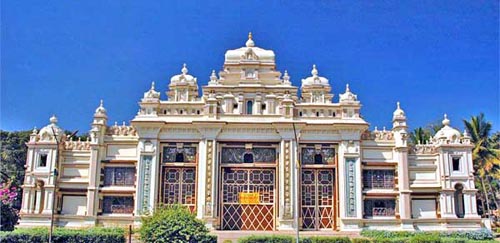Jaganmohan Palace

Information on Jaganmohan Palace (Mysore, Karnataka) - History & Architecture
The Jaganmohan Palace also known as Jayachamarajendra Art Gallery is located in the city of Mysore, Karnataka. Constructed in the year 1861 it served as a residence for the King of Mysore. In the contemporary scenario, the palace has been converted into art gallery. It is also at times used for the purpose of organizing functions. It is often regarded as one of the most beautiful monuments in the entire city.
Jaganmohan Palace Architecture
It is the architectural beauty of the palace that makes it one of the most magnificent structure in the city of Mysore. Notably, monument was made entirely on the basis of the Hindu architecture in a three storey structure. During the year 1900 the monument was renovated by adding an outside facade in the form of a function hall to the palace. The hall has three entries with each one of them is crafted on the designs of temples and others religious architectures. Another important feature of the architecture of the building is its interior walls which are uniquely decorated with murals. The paintings inside the building are relevant with the style of school of Mysore. The paintings are mainly influenced from the theme of dasara scene along with the sequences of the Jumboo Savari. Furthermore, a family of the royal family is also presented in the form of painting within the interior walls of the palace. These features are visual delight for the visitors as they can get a glimpse of the historical background of the Mysore dynasty.
Jaganmohan Palace History
Constructed in the year 1861, the building has a rich history associated with it. Krishnaraja Wodeyar III originally constructed the monument to provide an alternate residence for the royal family of Wodeyar. The original home for the royal family was destroyed by fire owing to which they need to shift to the Jaganmohan Palace and reside in the same till the year 1912. By the year 1902, Rajarshi Nalvadi was put into the throne of Mysore for which a momentous took place in the pavilion of the Palace. The importance of the ceremony can be comprehended from the fact that Lord Curzon (Viceroy of India) attended this royal event. Historical report also suggested that the palace was also used by the King for meeting with the ministers and officials of the Kingdom of Mysore. A special durbar takes place during the dasara time where many prominent figure of the state ensure their presence. By the year 1915, the palace was transformed into an art gallery after the royal family resided to their original residence. In the year 1955, the monument was named 'Sri Jayachamarajendra Art Gallery'. Notably, the convocations of the University of Mysore were held many a times in the Jaganmohan Palace.
Jaganmohan Palace Tourism Importance
The Jaganmohan Palace is one of the major attractions for the tourism sector of the city of Mysore. It presents for thee tourists, the rich heritage of the city of Mysore. The 150 years old paintings and other scenic beauties of the building attracts visitors from all parts of the country and the world. The auditorium and the art gallery which the palace was later transformed into can be of utmost interest for the youth visitors. It takes only 20 rupees of rickshaw ride to reach the palace from Mysore city. There are also small shops and stores in and around the palace which can again ensure a convenient tour for the visitors.
- Bangalore Monuments
- Bagalkot Monuments
- Belgaum Monuments
- Bellary Monuments
- Bidar Monuments
- Bijapur Monuments
- Chitradurga Monuments
- Coorg Monuments
- Dakshina Kannada Monuments
- Gadag Monuments
- Gulbarga Monuments
- Hassan Monuments
- Mysore Monuments
- Raichur Monuments
- Uttara Kannada Monuments
- Yadgir Monuments
- Andaman Nicobar Monuments
- Andhra Pradesh Monuments
- Assam Monuments
- Bihar Monuments
- Chhattisgarh Monuments
- New Delhi Monuments
- Goa Monuments
- Gujarat Monuments
- Haryana Monuments
- Himachal Pradesh Monuments
- Jammu and Kashmir Monuments
- Karnataka Monuments
- Kerala Monuments
- Madhya Pradesh Monuments
- Maharashtra Monuments
- Odisha Monuments
- Punjab Monuments
- Rajasthan Monuments
- Tamil Nadu Monuments
- Telangana Monuments
- Uttar Pradesh Monuments
- West Bengal Monuments